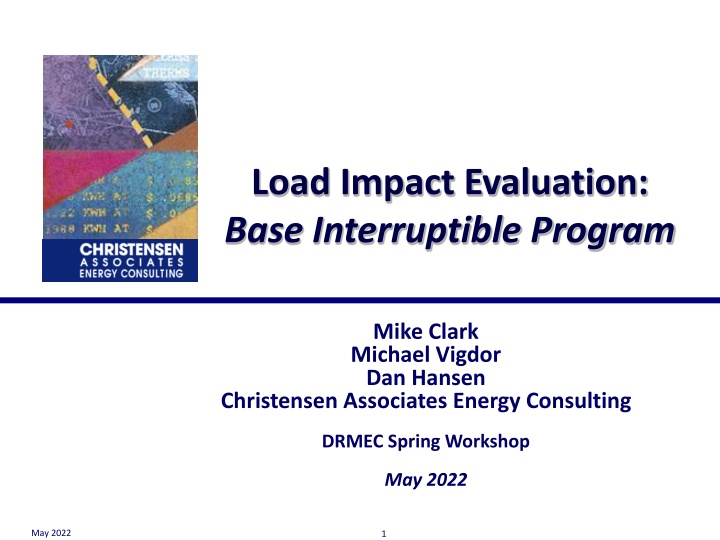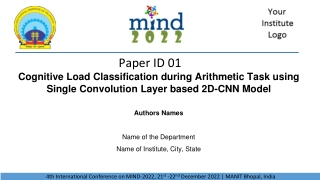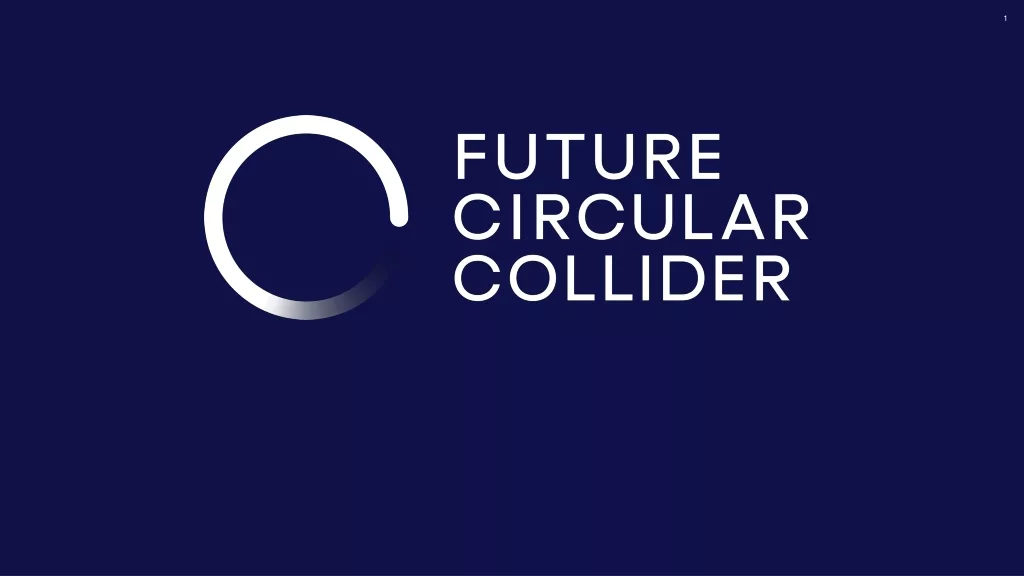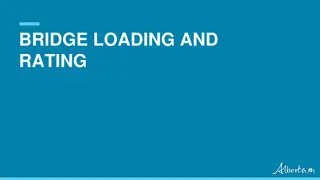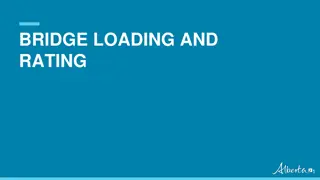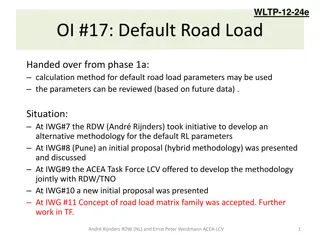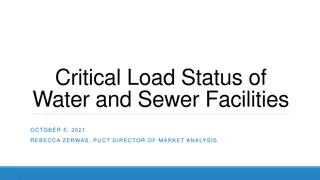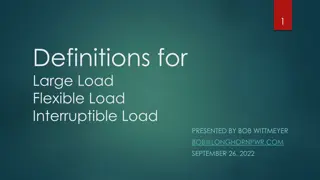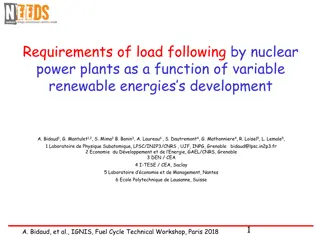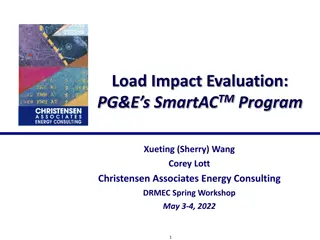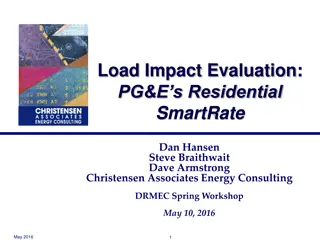Load Impact Evaluation: Interruptible Program Details
This content provides an in-depth analysis of the base interruptible program, detailing its methodology, load impacts, enrollment forecast, and program specifics for non-residential customers. It covers the ex-post and ex-ante methodologies used, individual regressions for estimating load impacts, and considerations for weather-sensitive loads. The Emergency DR program's features, customer commitments, and potential consequences for failing to meet energy reduction requirements are outlined. The content also delves into the program's variations across utilities to give a comprehensive understanding of its functioning and impact assessment.
Download Presentation

Please find below an Image/Link to download the presentation.
The content on the website is provided AS IS for your information and personal use only. It may not be sold, licensed, or shared on other websites without obtaining consent from the author.If you encounter any issues during the download, it is possible that the publisher has removed the file from their server.
You are allowed to download the files provided on this website for personal or commercial use, subject to the condition that they are used lawfully. All files are the property of their respective owners.
The content on the website is provided AS IS for your information and personal use only. It may not be sold, licensed, or shared on other websites without obtaining consent from the author.
E N D
Presentation Transcript
Load Impact Evaluation: Base Interruptible Program Mike Clark Michael Vigdor Dan Hansen Christensen Associates Energy Consulting DRMEC Spring Workshop May 2022 May 2022 1
Presentation Outline 1. Program Description 2. Ex-post Methodology 3. Ex-post Load Impacts 4. Ex-ante Methodology 5. Enrollment Forecast 6. Ex-ante Load Impacts May 2022 2
1. BIP Program Description Emergency DR program for non-residential customers, events triggered by CAISO or local system emergencies Customers receive a monthly capacity credit in exchange for a commitment to reduce energy consumption to their Firm Service Level (FSL) The FSL represents the customer s minimal operational requirements 15, 20, or 30-minute notice of events Failure to reduce load to the FSL can result in: excess energy charges, an increase in the FSL (& commensurate reduction in capacity credits), re-test events, or de-enrollment from the program Program specifics vary by utility May 2022 3
2. Ex-post Methodology Individual regressions were used to estimate BIP ex-post load impacts This method was chosen for two reasons: Difficulty in finding adequate control-group customers Some customers have volatile loads, so even customers that match reasonably well on average may not have a comparable load on a specific day Customer-specific specification search conducted to: Determine if each customer has a weather-sensitive load Find the best fitting weather and shape variables by groups defined by weather sensitivity and industry group May 2022 4
2. Ex-post Methodology (2) BIP load impacts generally do not change significantly with temperatures because the biggest responders do not have weather-sensitive loads However, there are weather-sensitive customers in BIP that cause the program reference load to change somewhat with temperatures Separate weekday versus weekend regression specifications are used, when applicable In 2021, there were no weekend events called May 2022 5
3. Ex-post Load Impacts: Events Date Day of Week PG&E SCE SDG&E Temp. & Sys. Load 6:00 - 8:00 p.m. 6/17/2021 Thursday Transmission Emergency 6:32 -8:32 p.m. Reliability 5:50 8:53 p.m. 7/9/2021 Friday PG&E Event on 7/9/2021 68 Customers were called one hour late to the PG&E event Around 7:30 p.m. start time May 2022 6
3. Ex-post Load Impacts: Events (2) No. of Available Dispatches 10 / month 1 / day 10 / month 1 / day Hours of Availability Hours of Actual Use No. of Actual Dispatches Utility 180 / year 6 / day 180 / year 6 / day 120 / year 4 / day PG&E 2 1 SCE 3.05 1 SDG&E 2 10 / month 1 May 2022 7
3. Ex-post Load Impacts: PG&E July 9th Event Day Event from 6:32 to 8:32 p.m. 310 customers enrolled 293 customers called Ref. Load = 238 MW (239) Load Impact = 155 MW (174) % Load Impact = 65% (73%) FSL = 53 MW (53) FSL Achievement = 84% (94%) Top 15 responders account for 60% of the total load impact Notes: There was only one event day in 2021 Impacts are summarized over the sole full event hour (HE 20) ( ) = Accounting for late notification (full effects described on next slide) May 2022 8
3. Ex-post Load Impacts: PG&E Late Notification Regular Notification Late Notification Group HE 19 20 21 19 20 21 19 20 21 Ref 138 137 137 101 101 102 239 238 239 Obs 72 46 52 99 37 20 171 83 71 LI 66 91 85 2 65 83 68 155 168 FSL 34 34 34 19 19 19 53 53 53 Achievement 63% 88% 83% 3% 79% 99% 36% 84% 90% 68 customers were called one hour late Response from late notification customers begins almost exactly one hour late We do not change any estimation of ex- post load impacts which leads to slightly lower results Regular Notification Late Notification All = Ex-Post partial hour = Ex-Post full hour = Used for Ex-Ante May 2022 9
3. Ex-post Load Impacts: SCE July 9th Event Day Event from 5:50 to 8:53 p.m. 344 customers enrolled 344 customers called Ref. Load = 551 MW Load Impact = 409 MW % Load Impact = 74% FSL = 115 MW FSL Achievement = 94% Top 15 responders account for 54% of the total load impact HE Ref Obs LI LI (%) FSL Achievement 18 19 20 21 556 551 552 551 510 165 121 123 46 387 430 428 8% 70% 78% 78% 115 115 115 115 10.3% 88.7% 98.7% 98.4% Notes: There was only one event day in 2021 Impacts are summarized over full event hours (HE 19 and 20) May 2022 10
3. Ex-post Load Impacts: SDG&E June 17th Day SDG&E only had one customer called on the 2021 event day Results are confidential to protect sensitive customer-level data This includes ex-ante forecasts which are built using 2021 ex-post results May 2022 11
4. Ex-ante Methodology Customers who have left BIP are not included Reference loads are simulated using the following: Customer-specific regressions to obtain effect of weather and time- period indicators on usage Ex-ante day types and weather conditions (e.g., August peak month day in a utility-specific 1-in-2 weather year) Biggest responders do not tend to have weather-sensitive loads Ex-ante load impacts are based on the most recent full or test / M&E event day for which customer s reference load was above their FSL, by customer May 2022 12
4. Ex-ante Methodology (2) Each customer s ex-ante load impact is set to its ex-post FSL achievement rate: Ex-post Achievement = Ex-post Load Impact / (Ref. FSL) Ex-ante Impact = Ex-post Achievement x (Ref. FSL) Additional Details Ex-Post Ex-Ante Ex-Post Achievement Load impact is zero if FSL is above the reference load 350 Full Compliance Load Impact 300 Full Compliance Load and Load Impact (MWh/h) Load Impact Load Impact 250 Load Impact Customers who have joined BIP are assigned the program-level FSL achievement rate (applied to their own reference loads and FSL, if available) 200 150 100 50 0 1 2 3 4 5 6 7 8 9 10 11 12 13 14 15 16 17 18 19 20 21 22 23 24 -50 Load impacts display little to no relationship with weather conditions Event Hours Reference Observed FSL Note: Example is provided for aggregate load; actual methodology is done at the per-customer level. May 2022 13
4. Ex-ante Methodology (3) Reference loads are adjusted for COVID 1. Estimate hourly per-customer COVID effects via regressions 2. Make assumption regarding COVID transition period 3. Apply per-customer COVID effect to reference loads based on the transition period June Aggregate Loads SCE COVID Transition Period Reduced Load due to COVID SCE: 17 MW PG&E: 0.9 MW SDG&E: 0 MW COVID adjustment for SCE is 17 MW during the RA window May 2022 14
5. Enrollment Forecast The table below shows August enrollment in each year of the forecast PG&E forecasts increased enrollment SCE forecasts flat enrollment SDG&E forecasts flat enrollment Utility 2022 2023 2024 2025 2026 2027 2028 2029 2030 2031 2032 PG&E 268 278 286 297 305 313 322 333 343 351 360 SCE 15-min 44 44 44 44 44 44 44 44 44 44 44 SCE 30-min 297 297 297 297 297 297 297 297 297 297 297 SDG&E 1 1 1 1 1 1 1 1 1 1 1 May 2022 15
6. Ex-ante Load Impacts: by Year and Weather Scenario Year Weather # SAIDs Load Impact (MW) Temp. ( F) FSL (MW) PG&E 1-in-2 170 93 Aug. 2022 268 54 PG&E PG&E 1-in-10 170 96 PG&E 1-in-2 227 93 Aug. 2032 360 72 PG&E 1-in-10 227 96 Year Weather # SAIDs Load Impact (MW) Temp. ( F) FSL (MW) SCE 1-in-2 SCE 1-in-10 SCE 1-in-2 SCE 1-in-10 503 505 523 525 88 93 88 93 Aug. 2022 (25% COVID) SCE 341 112 Aug. 2032 (0% COVID) 341 112 May 2022 16
6. Ex-ante Load Impacts: by Year and Weather Scenario (2) PG&E SCE Note: Aggregate load impacts above are for the month of August May 2022 17
6. Ex-ante Load Impacts: PG&E Ex-post vs. Ex-ante Ex-post / Ex-ante Reference Load (MW) Load Impact (MW) Temp. ( F) FSL (MW) FSL Date / Scenario # SAIDs Achievement July 9th Event Ex-post 293 238 155 96 53 84% July 9th Event adjusted for late notification August 2022 Typical Event Day Ex-post 293 239 174 94 53 94% Ex-ante 268 236 170 93 54 93% Per-customer reference loads, load impacts, and FSL Achievement are higher in ex-ante because of customers that remained on the program Relaxing of COVID impact has a small, but nearly negligible positive impact on future reference loads Total ex-anteLI and FSL Achievement is larger by assuming no late notifications, as there were in ex-post Note: All ex-ante forecasts from this point forward reflect the utility-specific 1-in-2 peak day May 2022 18
6. Ex-ante Load Impacts: PG&E, Previous vs. Current Typical Event Day 2022 Aggregate Per-customer When Created # SAIDs Reference Load (MW) Load Impact (MW) FSL (MW) Reference Load (kW) Load Impact (kW) Following PY2020 (Previous) Following PY2021 (Current) 308 240 187 56 780 608 268 236 170 54 881 633 Reference load and load impact decreased by 4 MW and 17 MW, respectively. Factors include (arrows indicate direction of load impact): Enrollment forecast decreased by 40 customers Reference loads adjusted for COVID of remaining customers FSL decreased from 56 MW to 54 MW FSL Achievement Rate decreased from 102% to 94% Per-customer reference load and load impacts higher COVID adjustment leads to higher reference loads Customers that remained are larger, on average. May 2022 19
6. Ex-ante Load Impacts: SCE Ex-post vs. Ex-ante Ex-post / Ex-ante Reference Load (MW) Load Impact (MW) Temp. ( F) FSL (MW) FSL Date / Scenario # SAIDs Achievement July 9th Event Ex-post 344 551 409 85 115 94% August 2022 Typical Event Day Ex-ante 341 614 502 88 112 100% Compositional Changes: Similar number of customers entering and leaving the program Customers who remained on the program are larger on average than those who left Scaling leads to 8 MW of additional load impact Relaxed COVID assumptions lead to 40 MW of additional load impact Ex-ante per-customer reference loads and load impacts are higher than ex-post because July 9th had relatively low reference loads compared to similar days (about 15 MW lower in non-event hours) May 2022 20
6. Ex-ante Load Impacts: SCE, Previous vs. Current Typical Event Day 2022 Aggregate Per-customer When Created # SAIDs Reference Load (MW) Load Impact (MW) FSL (MW) Reference Load (kW) Load Impact (kW) Following PY2020 (Previous) Following PY2021 (Current) 359 653 510 112 1,818 1,421 341 614 502 112 1,800 1,471 Reference load and load impact decreased by 39 MW and 8 MW, respectively. Factors include (arrows indicate direction of load impact): Enrollment forecast decreased by 18 customers Similar COVID adjustment across years FSL remained at 112 FSL Achievement Rate increased from 94% to 100% Per-customer reference load and load impacts similar in size (slightly smaller) May 2022 21
Questions? Contact Mike Clark Christensen Associates Energy Consulting Madison, Wisconsin mtclark@CAEnergy.com (608) 216-7163 Michael Vigdor Christensen Associates Energy Consulting Madison, Wisconsin mjvigdor@CAEnergy.com (608) 231-2266 May 2022 22
Load Impact Comparisons: PG&E, previous Ex-post vs. current Ex-post Aggregate Per-customer When Created # SAIDs Reference Load (MW) Load Impact (MW) Reference Load (kW) Load Impact (kW) FSL (MW) Ex-Post, Previous 494 294 202 76 595 408 Ex-Post, Current 293 238 155 53 813 531 Ex-Post, Current Adjusted 293 239 174 53 816 594 Reference load and load impact decreased by 56 MW and 57 MW, respectively. Factors include (arrows indicate direction of load impact): Late notifications for 68 customers Fewer customers on the program FSL decreased from 76 MW to 53 MW Per-customer reference load and load impacts higher COVID led to much smaller reference loads and impacts last year Customers that remained are larger, on average May 2022 23
Load Impact Comparisons: PG&E, previous Ex-ante vs. current Ex-post Aggregate Per-customer When Created # SAIDs Reference Load (MW) Load Impact (MW) Reference Load (kW) Load Impact (kW) FSL (MW) Following PY2020 (Previous) 308 234 183 56 761 593 Ex-Post, Current 293 238 155 53 813 531 Ex-Post, Current Adjusted Reference load increased by 4 MW and load impact decreased by 28 MW. Factors include (arrows indicate direction of load impact): Late notifications for 68 customers Fewer customers on the program 293 239 174 53 817 594 Per-customer reference load slightly higher, load impact lower Slightly larger customers called to the event on average 17 non-called customers had lower usage than the program average Late notification customers decrease per customer load impact May 2022 24
Load Impact Comparisons: SCE, previous Ex-post vs. current Ex-post Aggregate Per-customer When Created # SAIDs Reference Load (MW) Load Impact (MW) Reference Load (kW) Load Impact (kW) FSL (MW) Ex-Post, Previous 469 640 484 105 1,366 1,032 Ex-Post, Current 344 551 409 115 1,603 1,188 Reference load and load impact decreased by 89 MW and 75 MW, respectively. Factors include (arrows indicate direction of load impact): Enrollment decreased by 125 customers FSL increased from 105 to 115 FSL Achievement Rate increased from 94% to 100% Per-customer reference load and load impacts increased Most customers who left were smaller on average May 2022 25
Load Impact Comparisons: SCE, previous Ex-ante vs. current Ex-post Aggregate Per-customer When Created # SAIDs Reference Load (MW) Load Impact (MW) Reference Load (kW) Load Impact (kW) FSL (MW) Following PY2020 (Previous) Ex-Post, Current Reference load and load impact decreased by 79 MW and 76 MW, respectively. Factors include (arrows indicate direction of load impact): Enrollment decreased by 15 customers Customers did not return to pre-COVID levels Unusually low event day reference loads FSL Achievement Rate increased from 94% to 100% 351 627 488 109 1,786 1,391 344 551 409 115 1,603 1,188 Per-customer reference load and load impacts lower May 2022 26
